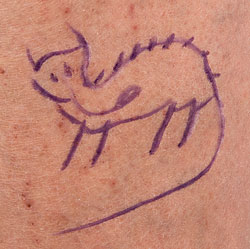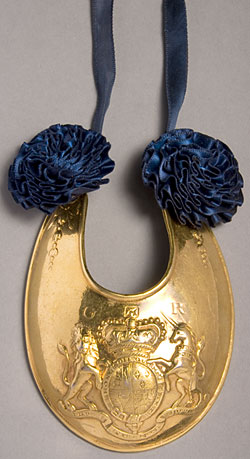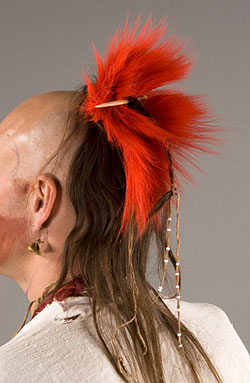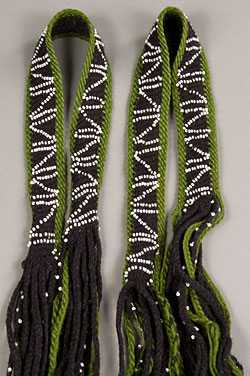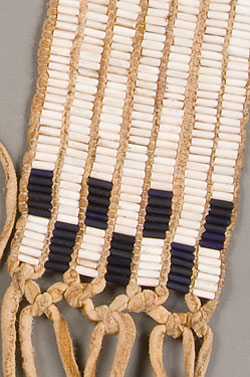




Advanced Search
Dress Up | 1st Person | African American Map | Now Read This | Magic Lens | In the Round | Tool Videos | Architecture | e-Postcards | Chronologies Turns Activities
Wôbanaki Men's Clothing from 1700Wôbanaki people did not have special clothing for sleeping. They would sleep in what seemed most suited for the season. In the winter this would mean wearing several layers to bed and in the hot weather one might sleep without clothing. The man pictured here carries a wool blanket for his bed. Hairstyles differed from group to group. In general, men living further north tended to keep their hair longer because the climate was cooler. Hairstyles would also change over the course of one’s life to reflect personal taste, or to signify alliance or mourning. Wôbanaki people believed it was a good idea to protect sensitive areas of the body, such as joints, the neck, ears and face, with jewelry, garters, and tattoos. By these means, they believed that dangerous energy or spirits could not enter their bodies. Jewelry with complicated patterns, reflective surfaces, and dangling and jangling pieces such as bells or metal cones, all helped to confuse harmful forces. Porcupine quill embroidery, beading, fringe, and ribbons might be added to the edges of clothing, both to offer protection and to encourage connections with desirable plants and animals. For instance, the edges of a breechclout might be decorated with ribbon, or the flaps on a pair of moccasins might be decorated with beads or porcupine quill embroidery. Among the numerous items available through trade in the early 1700s were wool and linen cloth, ready-made shirts and coats, knitted wool hats and mittens, glass beads, brass kettles, paint pigments such as vermillion, and metal axe and spear heads and knife blades. Native American people in New England would trade with the French in New France or the English in the American colonies. Items they received might come from England, France, Holland, or as far away as India. Go to interactive Flash version
Breechclout or BreechclothA breechclout, called “adhozoan”, is a strip of fabric or deerskin that goes between the legs and is held in place by a belt tied around the waist. The breechclout might be compared to modern-day shorts, underwear, or bathing suit. This man's breechclout is made of wool. Face PaintFace paint was used for a variety of reasons, including for disguise or to convey a mood or emotion. This man wears red paint to show that he is feeling happy. Red was associated with life, victory, blood, war, or enthusiasm.
TattoosTattoos were put on the body for a variety of reasons. Some were marks of valor, and others were used to cover skin injuries. Some tattoos, such as those across the chest of the man shown here, served as barriers against evil spirits. Tattoos were often placed on powerful parts of the body such as around the eyes, on the chest, joints, or the fingers used to draw a bow or pull the trigger of a gun. Tattoos were also used to deaden nerves, to relieve various aches, and to attract healing energy to specific parts of the body.
Gorget & BeadsWhen worn by a British or French military officer, a "gorget" was a metal badge of office, signifying that the man was not a common soldier. The Wôbanaki people liked to wear gorgets simply for adornment. People cut up brass kettles received in trade to make their own gorgets, or they made them from shells, such as the one shown here. This man's beads are called "wampum", or in Abenaki, "wôbôbial". The purple beads are made from the thickest part of quahog clam shells found along the New England seacoast. The white beads are made from clam, whelk and other white shells.
EarringsJewelry was worn by men and women. The earrings seen here are made of brass and quahog shell. People often slept with their earrings on. Earrings are called “saksohanal”.
ShirtThis man's shirt, called a “wihibaks”, is made of linen. It is the same style worn by European men, but they would wear theirs tucked into their breeches. ArmbandsThese are brass armbands, called “wpedinibial.” They were made by cutting up a kettle received in trade. LeggingsThese are deerskin leggings, called “medasal”, They are tied to a belt at the waist to keep them up. Leggings were worn for warmth and to protect one's legs when walking through scratchy undergrowth. MoccasinsThese are summer-weight moccasins with a center seam. They are made from the hide of a white-tailed deer. The Abenaki call all kinds of shoes "mkezenal". The English adapted this word into “moccasin”.
RoachThis hairpiece is called a "roach". It is made of dyed red hair from the tail of a male deer. The Penobscot word for roach is "wesewal", which means "faith". A roach was an important and deeply meaningful ornament.
GartersThis man wears garters, called “kiganibial”, just under his knees. They are made from wool yarn, using a technique called "fingerweaving". As the name suggests, fingerweaving is a way to weave by using just the fingers. These garters are decorated with white glass trade beads that were sewn on after the garters were woven. The garters help to keep the man's leggings in place.
Ring & BraceletThe ring and bracelet seen here are made from brass. The bracelet was made from a kettle. Wôbanaki people used some kettles received in trade for cooking and cut up others to make into jewelry. The ring is called a "bague a cachet" (plaque ring) by the French. This style of ring was given to Native people by traders, soldiers, politicians, and Catholic priests.
MedalThis silver medal is being worn simply as jewelry. Wôbanaki people believed that wearing a lot of shiny and sometimes noisy jewelry of various shapes helped to scare away evil energy and spirits.
CoatThis is a "French chief’s coat", made by the French and intended to be worn by the Native American chiefs with whom they traded. The coat is made of wool. It is interesting to note that the wool cloth preferred by the Wôbanakiak for clothing was usually either red or blue.
War ClubThis is a wooden war club. The clan symbol of its owner is carved just below the club head. The lines underneath might signify how many times the man had been to war, how many war party members there were, or how many prisoners were taken. A man might also decorate his war club with an image of his own face or copies of tattoos on his body.
Wampum BeltThis wampum belt is composed of glass beads. The Abenaki word for wampum is "wôbôbial". White signifies peace, clarity, calmness, and friendship. Dark beads signify conflict or complexity. The belt might have been a gift to the man holding it. The ends of the belt are knotted; among the Wôbanakiak, this might symbolize a personal belt belonging to this man.
PouchThis deerskin pouch is decorated with tufts of deer hair dyed red, embroidery of flattened, dyed porcupine quills, white glass beads, and cones made from a copper kettle. The cones would serve as bells, making a pleasant noise when the bag moved. A bundle of tobacco is attached to the bag's strap.
|
| |
Home | Online
Collection | Things
To Do | Turns Exhibit | Classroom | Chronologies My
Collection
About This Site | Site
Index | Site Search | Feedback

